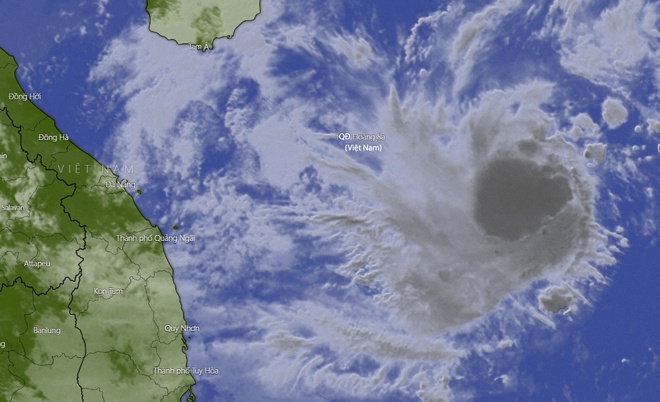On November 5, typhoon Goni could land on the mainland of Quang Ngai - Khanh Hoa provinces with strong winds of level 8, shock level 10. Storm circulation caused rain in Central Vietnam.
At 7:00, the storm center was 400 km southeast of Hoang Sa archipelago and kept strong winds at level 8, level 10 during the past hours.
In the next 24 hours, the danger zone due to typhoon impacts in the East Sea lies from latitude 12.5 to 17 degrees north latitude and from longitude 111.5 to 118.5 east longitude. All vessels operating in the danger zone are at high risk of being affected by strong winds.
On the morning of November 3, typhoon number 10 (Goni) maintained the strongest wind at level 8, jerked to level 10. The storm has barely gotten stronger in the past 6 hours.
Day and night, the storm travels in the southwest direction with the speed of 10 km / h. On the morning of November 4, the storm center was about 290 km southeast of the Hoang Sa archipelago. The intensity tends to increase gradually to level 8-9, and level 11

Typhoon Goni tends to move inland from Quang Ngai - Khanh Hoa provinces
This pattern maintains direction and speed for the following hours. At dawn of 5/11, the storm center was about 160 km east of Quang Ngai to Khanh Hoa. Strong wind strength reached level 9, shock level 11. The storm rose one level before entering the Central Coast.
On November 5, the storm entered the mainland provinces of Quang Ngai to Khanh Hoa and gradually weakened into a tropical depression and then turned into a low pressure area.
Thus, during the life cycle from now to landfall, the storm does not change direction and speed but moves mainly in the southwest direction, at 10 km / h.

Satellite images of Typhoon Goni at dawn of 3/11 showed that this pattern began to re-establish the cloud structure and circulate after one day of dispersion
Về cường độ đổ bộ, cơ quan khí tượng Hong Kong và Nhật Bản cùng chung nhận định là ở thời điểm tiến vào vùng biển các tỉnh Trung Bộ, bão chỉ duy trì sức gió mạnh 65 km/h, tương đương cấp 8, giật cấp 10.
Quá trình đi vào đất liền, bão có dấu hiệu suy yếu thành áp thấp nhiệt đới và chỉ đạt cường độ 40 km/h, tương đương cấp 6 vào rạng sáng 6/11. Lúc này, tâm áp thấp nhiệt đới nằm ngay trên đất liền các tỉnh Quảng Ngãi - Khánh Hòa.
Kịch bản bão suy yếu trước khi đổ bộ đất liền có thể xảy ra. Dù vậy, hoàn lưu bão vẫn bao trùm các tỉnh từ Đà Nẵng đến Bình Thuận, gây ra một đợt mưa cho khu vực bắt đầu từ tối 4/11.
Cụ thể, mưa lớn tiếp diễn tại Trung Bộ trong ngày 4-7/11. Các tỉnh từ Thừa Thiên - Huế đến Quảng Ngãi có thể hứng chịu lượng mưa phổ biến 300-400 mm/đợt.
Trong khi đó, khu vực Bình Định, Phú Yên và bắc Tây Nguyên có mưa nhỏ hơn, khoảng 100-200 mm. Ảnh hưởng của đợt mưa này, lũ trên các sông, đặc biệt là Quảng Nam và Quảng Ngãi khả năng lên báo động 2, báo động 3 trong những ngày tới.